Nikon OceanPro Handleiding
Nikon
Verrekijker
OceanPro
Bekijk gratis de handleiding van Nikon OceanPro (4 pagina’s), behorend tot de categorie Verrekijker. Deze gids werd als nuttig beoordeeld door 26 mensen en kreeg gemiddeld 5.0 sterren uit 13.5 reviews. Heb je een vraag over Nikon OceanPro of wil je andere gebruikers van dit product iets vragen? Stel een vraag
Pagina 1/4

双眼鏡/BINOCULARS/FERNGLÄSER/
JUMELLES/BINOCULARES/BINOCOLO
使用説明書/ Instruction manual / Bedienungsanleitung /
Mode d’emploi /Manual de instrucciones / Manuale di istruzioni
Jp
En De
Fr Es
It
各部名称
1 接眼レンズ
2 視度調整リング
3 中心軸
4 眼幅
5 接眼目当て
6 0ディオプター位置
7 指標
8 ストラップ取り付け部
9 対物レンズ
0 眼幅目盛
a 対物キャップ
b ストラップ
c 接眼キャップ
d ピント合わせリング
e 照明窓※
f コンパス※
g 照明スイッチ※
h 電池室カバー※
※7×50CFWPGLOBALCOMPASS
のみ
NOMENCLATURE
1 Eyepiece lens
2 Diopter adjustment ring
3 Central shaft
4 Interpupillary distance
5 Eyecup
6 0 (zero) diopter position
7 Diopter index
8 Strap eyelet
9 Objective lens
0 Interpupillary distance scale
a Objective lens cap
b Strap
c Eyepiece lens cap
d Focusing ring
e Aperture for lighting*
f Compass*
g Illumination switch*
h Battery chamber lid*
* 7×50 CF WP GLOBAL COMPASS only
TEILEBEZEICHNUNG
1 Okular
2 Dioptrien-Einstellring
3 Zentralachse
4 Pupillenabstand
5 Augenmuschel
6 Dioptrien-Position 0 (null)
7 Dioptrien-Skala
8 Riemenösen
9 Objektiv
0 Pupillenabstand-Skala
a Objektivdeckel
b Trageriemen
c Okulardeckel
d Scharfstellring
e Öffnung für Beleuchtung*
f Kompass*
g Beleuchtungsschalter*
h Batteriefachdeckel*
* Nur bei 7×50 CF WP GLOBAL COMPASS
コンパスの使い方(7×50 CF WP GLOBAL COMPASS)
本製品に搭載されているコンパスは、世界のどの地域でも磁界の北を指します。
コンパスは、一目盛1°を示します。
コンパスは次の手順で使用します。
1) 双眼鏡を水平に持ち、接眼を通して目標物を見ます。
2) 方位を知りたい目標物に向けて双眼鏡を動かします。
3) 視野内の下側に見える目盛が動きます。目盛の値は、目標物の方位を示します。
目盛の値 方位
コンパス
360° 北
90° 東
180° 南
270° 西
※双眼鏡は必ず水平に持ってください。水平でない場合、正しい値を得ることができません。
※照明窓を指などでふさがないでください。外光が遮られ、コンパスの目盛が暗くなります。
※本製品を磁石などの磁気製品(電気製品で磁気を発生するものも含む)に近づけると、正しい値を表示しないことがあり
ます。
電池について(7×50 CF WP GLOBAL COMPASS)
暗い場所でコンパスを使用する場合は、照明スイッチを押して使用してください。
電池の入れ方
1) コインを使い、電池室カバーを反時計回りに回して外します。
2) 電池(LR432個)を図のように入れます。
3) 電池室カバーを時計回りに回してねじ込みます。
防水シール用ゴムリングがカバーにはめこんでありますので、重くなりますが最後
まで完全にねじ込んでください。
※出荷時には電池はセットされていません。同梱の電池を入れてください。
※電池をセットしなくても、コンパスを読むことはできますが、暗いところでは読み
にくくなることがあります。
電池に関するご注意
電池は誤った使い方をすると破裂する恐れがあり、また液モレを起して、双眼鏡を腐
食させたり、手や衣類などを汚す原因となります。
次のことを必ず守ってください。
• +(プラス)と-(マイナス)の方向を確認して、正しくセットしてください。
• 電池が消耗したり、長時間(10日以上)使用しないときは、電池を取り出しておいてください。
• 電池を水や火の中に入れたり、分解したりしないでください。
• 電池を充電しないでください。
スケールの読み方(7×50 CF WP GLOBAL COMPASS)
本製品は遠くの物に合わせて視度調整をしますと、視野に図1のような1目盛が5ミルの単位となっているスケールがはっき
りと現われます。このスケールは、スケールの目盛を読んで、そこまでの「距離」や「目標物の大きさ」を測るために用いま
す。ただし距離を知りたいときは、目標物の大きさがわかっていなければなりません。反対に目標物の大きさを知りたいとき
は、距離がわかっていなければなりません。
1) 距離を知りたいとき
(目標物の大きさはわかっている)
距離= 目標物の大きさ
目盛の読み ×1,000 スケール
5mil
コンパス
図1
スケールはmil(ミル)という単位を使います。
1milは、おおよそ1000mの距離にある、1mの
大きさの物体を見込む角度に相当します。
1m
1,000m
1mil
目標物の大きさを目盛の読みで割り1000倍にします。
例:目標の大きさ 35m
目盛の読み 70mil
距離= 35
70 ×1,000=500(m)
2) 目標物の大きさを知りたいとき
(距離はわかっている)
目標物の大きさ= 距離×目盛の読み
1,000
距離に目盛の読みを掛けて1000で割ります。
例:距離 500m
目盛の読み70mil
=35(m)
目標物の大きさ= 500×70
1,000
仕様
形式
ポロプリズム単独繰り出し式
ポロプリズム中央繰り出し式
型名 7×50IFWP 7×50CFWP 7×50CFWP
GLOBALCOMPASS 10×50CFWP
倍率 (x) 7 7 7 10
対物レンズ有効径 (mm) 50 50 50 50
実視界 (°) 7.5 7.2 7.2 6.2
見掛け視界 (°)* 49.3 47.5 47.5 56.9
1000mにおける視界 (m) 131 126 126 108
ひとみ径 (mm) 7.1 7.1 7.1 5.0
明るさ 50.4 50.4 50.4 25.0
アイレリーフ (mm) 15.0 22.7 22.7 17.4
最短合焦距離 (m)** 25 10 10 17
眼幅調整範囲 (mm) 59 ~ 72 56 ~ 72 56 ~ 72 56 ~ 72
高さ (mm) 178 193 193 190
幅 (mm) 203 202 202 202
厚み (mm) 70 71 81 71
質量 (g) 1,115 1,115 1,130 1,070
環境 - - RoHs、WEEE -
電源 - - LR43電池×2 -
構造 防水(2m/5分間)と
窒素ガス充填
防水(1m/5分間)と
窒素ガス充填
防水(1m/5分間)と
窒素ガス充填
防水(1m/5分間)と
窒素ガス充填
* 関係式「tanω’=Γxtanω」で算出した値。見掛け視界:2ω’、倍率:Γ、実視界:2ω
** 調節をしていない正視眼の場合
構成
•双眼鏡
•ストラップ
•対物キャップ
•接眼キャップ
•ソフトケース
•電池LR43×2個(7×50CFWPGLOBALCOMPASSのみ)
日本語
• 仕様・外観などは改善のため予告なしに変更する場合があります。
• 本「使用説明書」に掲載されている文章・イラストなどの無断転載を禁じます。
アフターサービスについて
お買い上げいただきましたニコン双眼鏡を、安心してご愛用いただきますよう、次のとおり修理、アフターサービスを行っ
ております。
• 本製品の補修用性能部品(その製品の機能を維持するために必要な部品)は、製造打ち切り後も5年間を目安に保有
しております。ご使用いただいております製品が修理可能かどうかにつきましては、ご購入店、またはニコンのサー
ビス機関へお問い合わせください。
• ニコンのサービス機関につきましては、「ニコンサービス機関のご案内」をご覧ください。
付記
水没、火災、落下などによる故障または破損で全損と認められる場合は、修理が不可能となります。なお、この故障ま
たは破損の程度の判定はニコンのサービス機関におまかせください。
防水型について
この製品は1m(7×50IFWPは2m)の水深に5分間水没させても内部光学系に影響のない防水設計になっています。
防水型製品の特性
• 雨風の当たる場所や、湿気の多い場所などの悪条件下で使用しても、内部機能を損ねることがありません。
• 乾燥窒素の充填により、曇りやカビが生じにくくなっています。
使用上の注意点
• 密閉構造ではありませんので水中での使用はできません。また流水などで強い水圧をかけないでください。
• 本体可動部に水滴が付いたときは操作することをやめ、水滴を拭き取るようにしてください。
なお、防水性能を保持するために、定期的に点検を受けられることをおすすめします。
7×50 IF WP 7×50 CF WP
10×50 CF WP 7×50 CF WP GLOBAL COMPASS
English
• Specifications and design are subject to change without notice.
• No reproduction in any form of this “Instruction manual”, in whole or in part (except for brief quotation in critical articles or reviews), may be made without written authorization from
NIKON VISION CO., LTD.
Waterproof models:
All models shown are waterproof, and will suffer no damage to the optical system if submerged or dropped in water to a maximum depth of 1 meter (7×50 IF WP: 2m) for up to 5 minutes.
These products offer the following advantages:
• Can be used in conditions of high humidity, dust and rain without risk of damage.
• Nitrogen-filled design makes them resistant to condensation and mold.
Observe the following when using these products:
• As the unit does not have a perfectly sealed structure, it should not be operated nor held in running water.
• Any moisture should be wiped off before adjusting movable parts (focusing ring, eyepiece, etc.) of these products to prevent damage and for safety reasons.
To keep your binoculars in excellent condition, Nikon Vision recommends regular servicing by an authorized dealer.
En
Symbol for separate collection applicable in European countries
This symbol indicates that this battery is to be collected separately.
The following apply only to users in European countries.
• This battery is designated for separate collection at an appropriate collection point. Do not dispose of as household waste.
• For more information, contact the retailer or the local authorities in charge of waste management.
En
Symbol for separate collection applicable in European countries
This symbol indicates that this product is to be collected separately.
The following apply only to users in European countries.
• This product is designated for separate collection at an appropriate collection point. Do not dispose of as household waste.
• For more information, contact the retailer or the local authorities in charge of waste management.
Using the Compass (7×50 CF WP GLOBAL COMPASS)
The compass built into these binoculars points to the magnetic north, regardless of what region of the world you are in.
One scale mark on the compass indicates one degree.
Use the compass as in the following procedure.
1) Hold the binoculars horizontally and look at the object through the eyepieces.
2) Move the binoculars towards the object whose direction you want to know.
3) The scale marks, which are visible on the bottom within the field of view, move. The values indicate the direction of the object.
Scale mark Val. Direction
Compass
360° North
90° East
180° South
270° West
* Be sure to hold the binoculars horizontally. Otherwise, you cannot obtain correct values.
* Do not cover the aperture for lighting with your finger. Light from the outside will be blocked, and the scale marks will become dark and illegible.
* The compass does not indicate the correct value when brought near magnetic products (including electrical products that generate magnetic fields).
Battery (7×50 CF WP GLOBAL COMPASS)
When using the compass in dark places, press the illumination switch.
BATTERY INSTALLATION
1) Using a coin, remove the battery chamber lid by turning it counterclockwise.
2) Install the batteries (two LR43) as shown in the figure.
3) Replace the battery chamber lid by turning it clockwise.
Turning the lid may feel tight because it is fitted with a rubber ring as a waterproofing seal, but screw it in until it fits into position.
* The batteries are not installed at the time of shipment from the factory. Install the batteries included with the binoculars in the same
package.
* Although you can read the compass without batteries, it may become harder to read in dark places.
BATTERY PRECAUTIONS
Incorrect installation may cause battery rupturing or leakage that results in corrosion of the binoculars or stains on the user's hands or
clothes.
Make sure to observe the following.
• Confirm the + and - polarities of the batteries and install them correctly.
• Remove the batteries when they are depleted or when you will not use the binoculars for a long period of time (10 days or more).
• Do not throw the batteries into fire or water. Do not try to disassemble them.
• Do not recharge the batteries.
Reading the Scale (7×50 CF WP GLOBAL COMPASS)
When you focus the binoculars to a faraway object, the cross scale appears clearly in the field of view. One scale mark is equal to 5 mils (Fig.1). By reading this cross scale, you can measure the distance
to the object, or the real size of the object. However, the distance can be calculated only when you know the size of the object. Conversely, you have to know the distance to calculate the size.
1) To measure the distance (Size of the object is already known)
Distance = Size of object
Reading on the scale × 1,000
Scale
5mil
Compass
Fig.1
The scale uses a unit called "mil".
1 mil is equivalent to the angle for an object 1 meter tall at a distance of 1,000 meters.
1m
1,000m
1mil
Divide the size of the object by the reading on the scale and then multiply by 1,000.
Example: Size of the object is 35 meters.
The reading on the scale is 70 mils.
Distance = 35
70 × 1,000 = 500 (m)
2) To measure the size of the object (Distance is already known)
Size of the object = Distance × Reading on the scale
1,000
Multiply the distance by the reading on the scale and then divide by 1,000.
Example: Distance is 500 meters.
Reading on the scale is 70 mils.
= 35 (m)
Size of the object = 500 × 70
1,000
SPECIFICATIONS
Type
Porro prism individual focusing type
Porro prism central focusing type
Model 7×50 IF WP 7×50 CF WP 7×50 CF WP GLOBAL COMPASS 10×50 CF WP
Magnification (×) 7 7 7 10
Effective diameter of objective lens (mm) 50 50 50 50
Angular field of view (real) (°) 7.5 7.2 7.2 6.2
Angular field of view (apparent) (°)* 49.3 47.5 47.5 56.9
Field of view 1,000(m/yd.) (m) 131 126 126 108
(ft) 393 377 377 325
Exit pupil (mm) 7.1 7.1 7.1 5.0
Brightness 50.4 50.4 50.4 25.0
Eye relief (mm) 15.0 22.7 22.7 17.4
Close focusing distance (m)** 25 10 10 17
(ft)** 82.0 32.8 32.8 55.8
Interpupillary distance adjustment
(mm) 59-72 56-72 56-72 56-72
Length (mm) 178 193 193 190
(in) 7.0 7.6 7.6 7.5
Width (mm) 203 202 202 202
(in) 8.0 8.0 8.0 8.0
Depth (mm) 70 71 81 71
(in) 2.8 2.8 3.2 2.8
Weight (oz) 39.3 39.3 39.9 37.7
(g) 1,115 1,115 1,130 1,070
Environment – – RoHs, WEEE –
Power source – – Two LR43 batteries –
Structure Waterproof (up to 2 meter for 5
minutes) and nitrogen gas filled
Waterproof (up to 1 meter for 5
minutes) and nitrogen gas filled
Waterproof (up to 1 meter for 5
minutes) and nitrogen gas filled
Waterproof (up to 1 meter for 5
minutes) and nitrogen gas filled
* Calculated by the relational expression "tan ω' = Γx tan ω". Apparent angular field of view: 2 ω', Magnification: Γ, Real angular field of view: 2 ω.
** Without diopter adjustment.
SUPPLIED ITEMS
• Binoculars
• Strap
• Objective lens cap
• Eyepiece cap
• Soft case
• Two LR43 batteries (7×50 CF WP GLOBAL COMPASS only)
7×50 IF WP
7×50 CF WP/10×50 CF WP/7×50 CF WP GLOBAL COMPASS
Pass the strap through as shown in the figure.
Bringen Sie den Trageriemen wie in der Abbildung gezeigt an.
4
2
( )d
3
1
a
50
6
7
8
9
b
c
5
2
g
3
1
h
d
e
f
40
7
8
9
6
図のようにストラップを通してください。
Deutsch
• Änderungen der Konstruktion und der technischen Daten bleiben vorbehalten.
• Alle Rechte, auch die des auszugsweisen Nachdrucks (mit Ausnahme kurzer Zitate in technischen Besprechungen), ohne schriftliche Genehmigung durch NIKON VISION CO., LTD. bleiben
ausdrücklich vorbehalten.
Wasserdichte Modelle:
Alle gezeigten Modelle sind wasserdicht und bei völligem Eintauchen oder Hineinfallen in Wasser bis zu einer maximalen Tiefe von 1 Meter (7 × 50 IF WP: 2m) und für die Dauer von maximal
5 Minuten frei von einer Beschädigung des optischen Systems.
Diese Modelle bieten die folgenden Vorteile:
• Einsatz unter hoher Luftfeuchtigkeit, Staub und Regen ohne Beschädigungsrisiko
• Stickstofffüllung verhindert Kondensation und Schimmelbildung
Bei Einsatz dieser Modelle zu beachten:
• Da das Produkt nicht hermetisch abgedichtet ist, darf es unter fließendem Wasser weder betrieben noch gehalten werden.
• Zur Verhinderung von Schäden und aus Sicherheitsgründen dürfen die beweglichen Teile (z.B. Fokussierring und Okular) dieser Modelle erst dann betätigt werden, wenn etwaige
Feuchtigkeit abgewischt ist.
Damit Sie viele Jahre ungetrübte Freude an Ihrem Fernglas haben, empfiehlt Nikon Vision die regelmäßige Wartung durch einen autorisierten Fachhändler.
De
Symbol für getrennte Wertstoff-/Schadstoffsammlung in europäischen Ländern
Dieses Symbol zeigt an, dass diese Batterie separat entsorgt werden muss.
Folgendes gilt nur für Verbraucher in europäischen Ländern:
• Diese Batterie darf nur separat bei einer geeigneten SammeIsteIIe entsorgt werden. Eine Entsorgung im HausmüII ist unzulässig.
• Wenden Sie sich für nähere lnformationen bitte an Ihren Händler oder die vor Ort für AbfaIlentsorgung zuständigen Behörden.
De
Symbol für getrennte Wertstoff-/Schadstoffsammlung in europäischen Ländern
Dieses Symbol zeigt an, dass dieses Produkt separat entsorgt werden muss.
Folgendes gilt nur für Verbraucher in europäischen Ländern:
• Diese Produkt darf nur separat bei einer geeigneten SammeIsteIIe entsorgt werden. Eine Entsorgung im HausmüII ist unzulässig.
• Wenden Sie sich für nähere lnformationen bitte an Ihren Händler oder die vor Ort für AbfaIlentsorgung zuständigen Behörden.
Verwendung des Kompasses (7 × 50 CF WP GLOBAL COMPASS)
Der in diese Ferngläser integrierte Kompass zeigt immer zum magnetischen Nordpol, und zwar unabhängig von dem Ort, an dem Sie sich aufhalten.
Eine Skalenmarkierung auf dem Kompass entspricht einem Grad.
Verwenden Sie den Kompass entsprechend der folgenden Anleitung.
1) Halten Sie das Fernglas waagerecht, und blicken Sie durch die Okulare auf das Objekt.
2) Bewegen Sie das Fernglas in Richtung des Objekts, dessen Richtung Sie wissen möchten.
3) Die Skalenmarkierungen, die sich unten im Sehfeld befinden, verschieben sich. Dieser Wert gibt die Richtung des Objekts an.
Skalenmarkierungswert Richtung
Kompass
360° Norden
90° Osten
180° Süden
270° Westen
* Achten Sie darauf, das Fernglas waagerecht zu halten. Andernfalls können Sie keine korrekten Werte erzielen.
* Bedecken Sie die Öffnung für Beleuchtung nicht mit Ihren Fingern. Licht von außen wird abgeblendet, und die Skalenmarkierungen werden dunkel und unleserlich.
* Der Kompass zeigt keine korrekten Werte an, wenn sich das Fernglas in der Nähe magnetischer Produkte befindet (einschließlich elektrischer Produkte, die Magnetfelder erzeugen).
Batterie (7 × 50 CF WP GLOBAL COMPASS)
Bei Verwendung des Kompasses in dunkler Umgebung können Sie den Beleuchtungsschalter drücken.
EINSETZEN DER BATTERIE
1) Entfernen Sie unter Verwendung einer Münze den Batteriefachdeckel, indem Sie ihn entgegen dem Uhrzeigersinn drehen.
2) Legen Sie die Batterien (zwei Stück vom Typ LR43) wie in der Abbildung gezeigt ein.
3) Setzen Sie den Batteriefachdeckel wieder auf, und befestigen Sie ihn, indem Sie ihn im Uhrzeigersinn drehen.
Das Drehen des Batteriefachdeckels kann etwas schwergängig sein, weil er mit einem Gummiring zur Abdichtung gegen Wasser
ausgestattet ist. Drehen Sie ihn trotzdem so lange weiter, bis er sich in der vorgesehenen Position befindet.
* Die Batterien sind bei Auslieferung ab Werk noch nicht eingesetzt. Setzen Sie die Batterien ein, die im Lieferumfang des Fernglases
enthalten sind.
* Das Ablesen des Kompasses ist zwar auch ohne eingesetzte Batterien möglich, in dunklen Umgebungen kann es jedoch schwierig sein.
VORSICHTSMASSNAHMEN BEIM UMGANG MIT DER BATTERIE
Ein fehlerhaftes Einsetzen kann zur Beschädigung oder zum Auslaufen der Batterien führen, was im Fernglas Korrosion verursachen und auf
Händen und Kleidung des Benutzers Flecken hinterlassen kann.
Beachten Sie unbedingt die folgenden Punkte:
• Achten Sie beim Einlegen der Batterien auf die richtige Polarität (+ und -).
• Entnehmen Sie die Batterien, wenn diese leer sind oder wenn Sie das Fernglas über einen längeren Zeitraum (ab 10 Tagen) nicht
verwenden.
• Werfen Sie die Batterien nicht ins Feuer oder ins Wasser. Versuchen Sie nicht, die Batterien auseinanderzubauen.
• Versuchen Sie nicht, die Batterien wieder aufzuladen.
Ablesen der Skala (7 × 50 CF WP GLOBAL COMPASS)
Wenn Sie das Fernglas auf ein weit entferntes Objekt richten, erscheint die Kreuzskala deutlich sichtbar im Sehfeld. Eine Skalenmarkierung entsprich dabei 5 mil (artilleristischen Strichen) (Abb.1).
Durch Ablesen dieser Kreuzskala können Sie die Entfernung des Objekts messen oder die reale Größe des Objekts bestimmen. Die Entfernung lässt sich jedoch nur berechnen, wenn Sie die Größe des
Objekts kennen. Und umgekehrt müssen Sie die Entfernung kennen, um die Größe berechnen zu können.
1) So messen Sie die Entfernung (Größe des Objekts ist bekannt)
Entfernung = Größe des Objekts
Ablesewert auf der Skala × 1.000
Skala
5mil
Kompass
Abb.1
Die Skala verwendet die Einheit „mil“ = artilleristische Striche.
1 mil entspricht dem Winkel für ein 1 Meter hohes Objekt in einer Entfernung von
1.000 Metern.
1m
1,000m
1mil
Teilen Sie die Größe des Objekts durch den Ablesewert auf der Skala, und multiplizieren
Sie das Ergebnis mit 1.000.
Beispiel: Die Größe des Objekts beträgt 35 Meter.
Der Ablesewert auf der Skala beträgt 70mil.
Entfernung = 35
70 × 1.000 = 500 (m)
2) So messen Sie die Größe (Entfernung des Objekts ist bekannt)
Größe des Objekts = Entfernung x Ablesewert auf der Skala
1.000
Multiplizieren Sie die Entfernung mit dem Ablesewert auf der Skala, und dividieren Sie
das Ergebnis dann durch 1.000.
Beispiel: Die Entfernung beträgt 500 Meter.
Der Ablesewert auf der Skala beträt 70mil.
= 35 (m)
Größe des Objekts = 500 × 70
1.000
TECHNISCHE DATEN
Typ
Einzel-Fokussierung mit Porro-Prisma
Mittelfokussierung mit Porro-Prisma
Modell 7×50 IF WP 7 × 50 CF WP 7 × 50 CF WP GLOBAL COMPASS 10 × 50 CF WP
Vergrößerung (×) 7 7 7 10
Effektiver Objektivdurchmesser (mm) 50 50 50 50
Winkelsehfeld (objektiv) (°) 7,5 7,2 7,2 6,2
Winkelsehfeld (subjektiv) (°)* 49,3 47,5 47,5 56,9
Sehfeld auf 1.000 m/Yard (m) 131 126 126 108
(ft) 393 377 377 325
Austrittspupille (mm) 7,1 7,1 7,1 5,0
Lichtstärke 50,4 50,4 50,4 25,0
Abstand der Austrittspupille (mm) 15,0 22,7 22,7 17,4
Mindestdistanz (m)** 25 10 10 17
(ft)** 82,0 32,8 32,8 55,8
Einstellung Pupillenabstand
(mm) 59-72 56-72 56-72 56-72
Länge (mm) 178 193 193 190
(in) 7,0 7,6 7,6 7,5
Breite (mm) 203 202 202 202
(in) 8,0 8,0 8,0 8,0
Tiefe (mm) 70 71 81 71
(in) 2,8 2,8 3,2 2,8
Gewicht (oz) 39,3 39,3 39,9 37,7
(g) 1.115 1.115 1.130 1.070
Umgebung – – RoHs, WEEE –
Stromquelle – – Zwei LR43-Batterien –
Struktur Wasserdicht (bis zu 2 Meter für 5
Minuten) und stickstoffgasgefüllt
Wasserdicht (bis zu 1 Meter für 5
Minuten) und stickstoffgasgefüllt
Wasserdicht (bis zu 1 Meter für 5
Minuten) und stickstoffgasgefüllt
Wasserdicht (bis zu 1 Meter für 5
Minuten) und stickstoffgasgefüllt
* Wert gemäß dem relationalen Ausdruck „tan ω‘ = Γx tan ω“. Subjektives Winkelsehfeld: 2 ω‘, Vergrößerung: Γ, Objektives Winkelsehfeld: 2 ω.
** Ohne Dioptrien-Einstellung
LIEFERUMFANG
• Fernglas
• Trageriemen
• Objektivdeckel
• Okulardeckel
• Weichtasche
• Zwei LR43-Batterien (nur bei 7 × 50 CF WP GLOBAL COMPASS)
a


Français
• Les caractéristiques techniques et la conception peuvent être modifiées sans préavis.
• Ce mode d’emploi ne peut être reproduit sous quelque forme que ce soit, en partie ou en totalité (sauf pour de brefs extraits dans la presse), sans l’autorisation écrite de NIKON VISION CO.,
LTD.
Étanchéité à l’eau :
Tous les modèles présentés étant étanches, leur système optique ne s’abîmera pas s’ils sont immergés ou tombent dans l’eau jusqu’à une profondeur maximale de 1mètre (2mètres pour le
modèle 7×50 IF WP) pendant 5minutes maximum.
Ces modèles offrent les avantages suivants :
• Ils sont utilisables sous forte humidité, poussière et pluie sans risques de dommages.
• Leur conception à injection d’azote les rend résistants à la condensation et aux moisissures.
Respectez les consignes suivantes lorsque vous utilisez ces modèles :
• Comme leur structure n’est pas parfaitement étanche, ils ne doivent pas être utilisés ou maintenus sous l’eau courante.
• Essuyez toute trace d’humidité avant de régler les parties mobiles (molette de mise au point, oculaire, etc.) pour éviter tout dégât et pour des raisons de sécurité.
Pour maintenir vos jumelles en excellent état, Nikon Vision vous conseille de les faire entretenir régulièrement par un revendeur agréé.
Fr
Symbole pour la collecte sélective applicable aux pays européens
Ce symbole indique que cette batterie doit être collectée séparément.
Les mesures suivantes concernent uniquement les utilisateurs européens.
• Cette batterie doit être jetée séparément dans un point de collecte approprié. Ne la jetez pas dans une
poubelle réservée aux ordures ménagères.
• Pour plus d’ informations, contactez le détaillant ou les autorités locales responsables de la gestion des
ordures.
Fr
Symbole pour la collecte sélective applicable aux pays européens
Ce symbole indique que ce produit doit être collectée séparément.
Les mesures suivantes concernent uniquement les utilisateurs européens.
• Ce produit doit être jetée séparément dans un point de collecte approprié. Ne la jetez pas dans une poubelle réservée aux ordures ménagères.
• Pour plus d’ informations, contactez le détaillant ou les autorités locales responsables de la gestion des ordures.
Utilisation de la boussole (7×50 CF WP GLOBAL COMPASS)
La boussole intégrée à ces jumelles pointe vers le nord magnétique, quelle que soit la région du monde où vous vous trouvez.
Une graduation de la boussole correspond à un degré.
Pour utiliser la boussole, procédez comme suit.
1) Tenez les jumelles à l’horizontale et visez l’objet à travers les oculaires.
2) Déplacez les jumelles vers l’objet dont vous souhaitez connaître la direction.
3) Les graduations, qui sont visibles à la base dans le champ de vision, se déplacent. Cette valeur indique la direction de l’objet.
Valeur graduation Direction
Boussole
360° Nord
90° Est
180° Sud
270° Ouest
* Veillez à bien tenir les jumelles à l’horizontale. Sinon, les valeurs seront faussées.
* N’obturez pas la fenêtre pour la lumière avec votre doigt. La lumière provenant de l’extérieur serait bloquée et les graduations deviendraient sombres et illisibles.
* Les valeurs indiquées par la boussole sont faussées lorsqu’elle se trouve à proximité d’objets magnétiques (notamment d’appareils électriques qui produisent un champ magnétique).
Español
• Las especificaciones y el diseño están sujetos a cambios sin previo aviso.
• Se prohíbe la reproducción total o parcial de este “Manual de instrucciones” (salvo para citas breves en publicaciones o reseñas especializadas) sin la previa autorización por escrito de NIKON
VISION CO., LTD.
Modelos estancos:
Todos los modelos son sumergibles, y sus sistemas ópticos no sufrirán daños en caso de sumergirse o caerse en el agua de una profundidad máxima de 1 metro (7×50 IF WP: 2 metros) durante
un máximo de 5 minutos.
Estos productos ofrecen las siguientes ventajas:
• Pueden utilizarse en entornos de alta humedad, polvo y lluvia sin riesgos de daños.
• El diseño con carga de nitrógeno los hace resistente a la condensación y el moho.
Cuando utilice estos productos, tenga en cuenta lo siguiente:
• Dado que la unidad no tiene una estructura perfectamente estanca, no debe exponérsela a agua en circulación.
• Es necesario secar la humedad antes de ajustar piezas móviles (mando de enfoque, visor, etc.) de estos productos para evitar daños y por motivos de seguridad.
Para mantener los binoculares en excelentes condiciones, Nikon Vision recomienda confiar su mantenimiento periódico a un distribuidor autorizado.
Es
Símbolo para recogida separada aplicable en países Europeos
Este símbolo indica que esta batería se recogerá por separado.
Lo siguiente sólo se aplicará a usuarios en países europeos.
• Esta batería p2-ha sido designada para su recogida en un punto de recogida apropiado. No la tire como desecho doméstico.
• Para más información, contacte con el vendedor o autoridades locales a cargo de la gestión de residuos.
Es
Símbolo para recogida separada aplicable en países Europeos
Este símbolo indica que esta producto se recogerá por separado.
Lo siguiente sólo se aplicará a usuarios en países europeos.
• Esta producto p2-ha sido designada para su recogida en un punto de recogida apropiado. No la tire como desecho doméstico.
• Para más información, contacte con el vendedor o autoridades locales a cargo de la gestión de residuos.
Italiano
• Design e dati caratteristici sono soggetti a variazioni senza preavviso.
• Senza autorizzazione scritta di NIKON VISION CO., LTD., non è possibile riprodurre in nessun modo, in tutto o in parte, il presente manuale (salvo brevi citazioni in recensioni o articoli critici).
Modelli impermeabili:
Tutti i modelli indicati sono impermeabili, e pertanto il sistema ottico non si danneggia nemmeno se li si immerge o li si lascia cadere in acqua sino a una profondità massima di 1 metro (per il
modello 7×50 IF WP: 2 m) per un massimo di 5 minuti.
Questi prodotti offrono i seguenti vantaggi:
• Possono essere usati in condizioni di elevata umidità, polvere e pioggia senza rischi di danni.
• La struttura riempita di azoto li rende resistenti a condensa e muffa.
Rispettare quanto segue quando si utilizzano questi prodotti:
• Dato che l’unità non p2-ha una struttura perfettamente a tenuta, non deve essere né utilizzata né tenuta in acqua corrente.
• Rimuovere eventuali tracce di condensa prima di sistemare le parti mobili (manopola di messa a fuoco, oculari, ecc.) di questi prodotti, in modo da prevenire l’insorgere di danni e per motivi
di sicurezza.
Per conservare il binocolo in condizioni ottimali, Nikon Vision raccomanda di far eseguire una manutenzione regolare da un rivenditore autorizzato.
NOMENCLATURE
1 Oculaire
2 Bague de réglage dioptrique
3 Axe central
4 Distance interpupillaire
5 Œilleton
6 Position de 0 (zéro) dioptrique
7 Index dioptrique
8 Œillet pour la courroie
9 Objectif
0 Échelle de distance interpupillaire
a Capuchon d’objectif
b Courroie
c Capuchon d’oculaire
d Bague de mise au point
e Fenêtre pour la lumière*
f Boussole*
g Commutateur d’éclairage*
h Couvercle du logement des piles*
* 7×50 CF WP GLOBAL COMPASS uniquement
NOMENCLATURA
1 Lente del visor
2 Anillo de ajuste de dioptrías
3 Eje central
4 Distancia interpupilar
5 Cubreojos tipo copa
6 Posición de cero (0) dioptrías
7 Índice de dioptrías
8 Ojo para la correa
9 Lente del objetivo
0 Escala de distancia interpupilar
a Tapa de la lente del objetivo
b Correa
c Tapa de la lente del visor
d Aro de enfoque
e Abertura de iluminación*
f Brújula*
g Interruptor de iluminación*
h Tapa del compartimento de baterías*
* 7×50 CF WP GLOBAL COMPASS solamente
NOMENCLATURA
1 Lente dell’oculare
2 Anello di regolazione diottrica
3 Albero centrale
4 Distanza interpupillare
5 Paraocchio
6 Posizione diottrica di 0 (zero)
7 Indice di regolazione diottrica
8 Occhiello della cinghietta a tracolla
9 Obiettivo
0 Scala della distanza interpupillare
a Copriobiettivo
b Cinghietta a tracolla
c Cappuccio per oculari
d Anello di messa a fuoco
e Apertura di illuminazione*
f Bussola*
g Interruttore di illuminazione*
h Coperchio dell’alloggiamento della batteria*
* Solo per il MODELLO 7×50 CF WP GLOBAL COMPASS
7×50 IF WP
7×50 CF WP/10×50 CF WP/7×50 CF WP GLOBAL COMPASS
4
2
( )d
3
1
a
50
6
7
8
9
b
c
5
2
g
3
1
h
d
e
f
40
7
8
9
6
Printed in Japan (828C)3DE/1601
Piles (7×50 CF WP GLOBAL COMPASS)
Lorsque vous utilisez la boussole dans l’obscurité, appuyez sur le commutateur d’éclairage.
INSTALLATION DES PILES
1) À l’aide d’une pièce de monnaie, retirez le couvercle du logement des piles en le dévissant dans le sens antihoraire.
2) Installez les piles (deux LR43) comme l’illustre la figure.
3) Revissez le couvercle du logement des piles dans le sens horaire.
Il se peut que le couvercle soit un peu dur à tourner car il est muni d’un joint d’étanchéité en caoutchouc, mais vissez-le jusqu’à ce qu’il
soit bien en place.
* Les piles ne sont pas installées au moment de l’expédition au départ de l’usine. Installez vous-même les piles livrées dans l’emballage
des jumelles.
* Vous pouvez toutefois lire la boussole sans les piles, mais cela risque d’être difficile dans l’obscurité.
PRÉCAUTIONS À PRENDRE AVEC LES PILES
Si les piles sont mal installées, elles risquent de se fissurer ou de fuir, ce qui pourrait faire rouiller les jumelles et tacher les mains ou les
vêtements de l’utilisateur.
Veillez à respecter les consignes suivantes.
• Vérifiez les polarités + et – des piles et installez-les correctement.
• Retirez les piles lorsqu’elles sont à plat et lorsque vous ne prévoyez pas d’utiliser pas les jumelles pendant un long moment (10jours ou plus).
• Ne jetez pas les piles dans le feu ou dans l’eau. N’essayez pas de les démonter.
• Ne rechargez pas les piles.
Lecture de l’échelle (7×50 CF WP GLOBAL COMPASS)
Lorsque vous faites la mise au point des jumelles sur un objet lointain, l’échelle en croix apparaît clairement dans le champ de vision. Une graduation équivaut à 5mils (Fig. 1). En lisant cette échelle,
vous pouvez mesurer la distance à l’objet, ou bien sa taille réelle. Cependant, vous ne pouvez calculer cette distance que si vous connaissez la taille de l’objet. Inversement, vous devez connaître la
distance pour pouvoir calculer sa taille.
1) Pour mesurer la distance (la taille de l'objet est déjà connue)
Distance = Taille de l'objet
Valeur mesurée sur l'échelle × 1 000
Échelle
5mils
Boussole
Fig.1
L'échelle utilise une unité appelée millième angulaire et abrégée en "mil".
1 mil correspond à l'angle sous lequel on voit un objet de 1mètre de haut à une
distance de 1000mètres.
1m
1,000m
1mil
Divisez la taille de l'objet par la valeur indiquée sur l'échelle et multipliez par 1000.
Exemple : La taille de l'objet est de 35mètres.
La valeur mesurée sur l'échelle est de 70mils.
Distance = 35
70 × 1000 = 500 (m)
2) Pour mesurer la taille de l'objet (la distance est déjà connue)
Taille de l'objet = Distance x Valeur mesurée sur l'échelle
1 000
Multipliez la distance par la valeur indiquée sur l'échelle et divisez par 1000.
Exemple : la distance est de 500mètres.
La valeur mesurée sur l'échelle est de 70 mils.
= 35 (m)
Taille de l'objet = 500 × 70
1 000
CARACTÉRISTIQUES
Type
À prisme de Porro et mise au point
individuelle
À prisme de Porro et mise au point centrale
Modèle 7×50 IF WP 7×50 CF WP 7×50 CF WP GLOBAL COMPASS 10×50 CF WP
Grossissement (×) 7 7 7 10
Diamètre effectif de l'objectif (mm) 50 50 50 50
Champ de vision angulaire (réel) (°) 7,5 7,2 7,2 6,2
Champ de vision angulaire (apparent) (°)* 49,3 47,5 47,5 56,9
Champ de vision à 1000 (m/yards) (m) 131 126 126 108
(pieds) 393 377 377 325
Pupille de sortie (mm) 7,1 7,1 7,1 5,0
Luminosité 50,4 50,4 50,4 25,0
Dégagement oculaire (mm) 15,0 22,7 22,7 17,4
Distance minimale de mise au point (m)** 25 10 10 17
(pieds)** 82,0 32,8 32,8 55,8
Réglage de la distance interpupillaire
(mm) 59-72 56-72 56-72 56-72
Longueur (mm) 178 193 193 190
(pouces) 7,0 7,6 7,6 7,5
Largeur (mm) 203 202 202 202
(pouces) 8,0 8,0 8,0 8,0
Profondeur (mm) 70 71 81 71
(pouces) 2,8 2,8 3,2 2,8
Poids (oz) 39,3 39,3 39,9 37,7
(g) 1 115 1 115 1 130 1 070
Conformité – – RoHs, WEEE –
Alimentation – – Deux piles LR43 –
Structure Étanche à l'eau (jusqu'à 2mètre
pendant 5minutes) et remplie d'azote
Étanche à l'eau (jusqu'à 1mètre
pendant 5minutes) et remplie d'azote
Étanche à l'eau (jusqu'à 1mètre
pendant 5minutes) et remplie d'azote
Étanche à l'eau (jusqu'à 1mètre
pendant 5minutes) et remplie d'azote
* Calculé selon la formule : «tan ω’ = Γx tan ω». Champ de vision apparent = 2 ω’, Grossissement = Γ, Champ de vision réel = 2 ω.
** Sans réglage dioptrique.
ÉLÉMENTS FOURNIS
• Jumelles
• Courroie
• Capuchon d'objectif
• Capuchons d'oculaire
• Étui souple
• Deux piles LR43 (7×50 CF WP GLOBAL COMPASS uniquement)
Faites passer la courroie comme indiqué sur la figure.
Pase la correa como se indica en la figura.
Fate passare la cinghietta a tracolla come mostrato
nella figura.
Uso de la brújula (GLOBAL COMPASS 7 × 50 CF WP)
La brújula incorporada a estos binoculares apunta al norte magnético, independientemente de cuál sea la región del mundo en que se encuentre.
Una marca en la escala de la brújula indica un grado.
Para utilizar la brújula, efectúe el siguiente procedimiento.
1) Sostenga los binoculares en posición horizontal y observe al objeto a través de los visores.
2) Mueva los binoculares hacia el objeto cuyo sentido desee conocer.
3) Las marcas de escala, visibles en la parte inferior del campo de visión, se mueven. Estos valores indican el sentido del objeto.
Valor en la marca de escala Sentido
Brújula
360° Norte
90° Este
180° Sur
270° Oeste
* Asegúrese de sostener los binoculares horizontalmente. De lo contrario no le será posible obtener valores correctos.
* No cubra la abertura de iluminación con el dedo. La luz exterior quedará bloqueada, y las marcas de escala se oscurecerán y tornarán ilegibles.
* La brújula no indicará el valor correcto si se la aproxima a productos magnéticos (incluyendo productos eléctricos que generen campos magnéticos).
Baterías (GLOBAL COMPASS 7 x 50 CF WP)
Si utiliza la brújula en lugares oscuros, pulse el interruptor de iluminación.
INSTALACIÓN DE LAS BATERÍAS
1) Utilizando una moneda, retire la tapa del compartimento de las baterías girándola en sentido contrario a las agujas del reloj.
2) Instale las baterías (dos LR43), como se indica en la figura.
3) Vuelva a colocar la tapa del compartimento de las baterías girándola en el sentido de las agujas del reloj.
Es posible que tenga que esforzarse para girar la tapa, p2-ya que está equipada con un aro de goma como junta estanca. No obstante,
gírela hasta encajarla en su posición.
* Las baterías no llegan instaladas de fábrica. Instale las baterías incluidas con los binoculares en el mismo paquete.
* Aunque es posible realizar lecturas de la brújula sin baterías, puede resultarle más difícil en lugares oscuros.
PRECAUCIONES CON LAS BATERÍAS
Una instalación incorrecta puede provocar la rotura de las baterías, o fugas desde las mismas que conllevan la corrosión de los binoculares o
manchas en las manos o prendas del usuario.
Asegúrese de tener en cuenta lo siguiente.
• Confirme las polaridades + y - de las baterías, e instálelas correctamente.
• Retire las baterías cuando se hayan agotado o si no va a utilizar los binoculares durante un período prolongado (10 o más días).
• No tire las baterías al fuego o al agua. No intente desmontarlas.
• No recargue las baterías.
Lectura de la escala (7×50 CF WP GLOBAL COMPASS)
Al enfocar los binoculares en un objeto lejano, la escala de cruz aparecer claramente en el campo de visión. Una marca de escala equivale a 5 mils (Fig. 1). Leyendo la escala podrá medir la distancia
hasta el objeto, o bien conocer el tamaño real del mismo. Sin embargo, la distancia solamente podrá ser calculada si conoce el tamaño del objeto. Y viceversa, tendrá que conocer la distancia para
calcular el tamaño.
1) Para medir la distancia (ya se conoce el tamaño del objeto)
Distancia = Tamaño del objeto
Lectura de la escala × 1.000
Escala
5 mils
Brújula
Fig. 1
La escala utiliza una unidad denominada "mil".
1 mil equivale al ángulo de un objeto de 1 metro de altura a una distancia de 1.000 metros.
1m
1,000m
1mil
Divida el tamaño del objeto por la lectura de la escala y multiplicando el valor por 1.000.
Ejemplo: El objeto tiene un tamaño de 35 metros.
La lectura de la escala es de 70 mils.
Distancia = 35
70 × 1.000 = 500 (m)
2) Para medir el tamaño del objeto (ya se conoce la distancia)
Tamaño del objeto = Distancia x lectura de la escala
1.000
Multiplique la distancia por la lectura de la escala y, a continuación, divida el resultado
en 1.000.
Ejemplo: La distancia son 500 metros.
La lectura de la escala es de 70 mils.
= 35 (m)
Tamaño del objeto = 500 × 70
1.000
ESPECIFICACIONES
Tipo
Tipo de enfoque individual de prisma Porro
Tipo de enfoque centralizado de prisma Porro
Modelo 7×50 IF WP 7×50 CF WP 7 x 50 CF WP GLOBAL COMPASS 10×50 CF WP
Ampliación (×) 7 7 7 10
Diámetro efectivo de la lente del
objetivo
(mm) 50 50 50 50
Campo de visión angular (real) (°) 7,5 7,2 7,2 6,2
Campo de visión angular (aparente) (°)* 49,3 47,5 47,5 56,9
Campo de visión 1.000 (m/yd.) (m) 131 126 126 108
(pies) 393 377 377 325
Pupila de salida (mm) 7,1 7,1 7,1 5,0
Brillo 50,4 50,4 50,4 25,0
Descanso ocular (mm) 15,0 22,7 22,7 17,4
Distancia cercana de enfoque (m)** 25 10 10 17
(pies)** 82,0 32,8 32,8 55,8
Ajuste de distancia interpupilar
(mm) 59-72 56-72 56-72 56-72
Longitud (mm) 178 193 193 190
(pulg) 7,0 7,6 7,6 7,5
Anchura (mm) 203 202 202 202
(pulg) 8,0 8,0 8,0 8,0
Profundidad (mm) 70 71 81 71
(pulg) 2,8 2,8 3,2 2,8
Peso (oz) 39,3 39,3 39,9 37,7
(g) 1.115 1.115 1.130 1.070
Medio ambiente – – RoHs, WEEE –
Alimentación eléctrica – – Dos baterías LR43 –
Estructura Sumergible (hasta 2 metros en 5
minutos) y cargada de gas nitrógeno
Sumergible (hasta 1 metros en 5
minutos) y cargada de gas nitrógeno
Sumergible (hasta 1 metros en 5
minutos) y cargada de gas nitrógeno
Sumergible (hasta 1 metros en 5
minutos) y cargada de gas nitrógeno
* Calculado mediante la expresión relacional “tan ω’ = Γx tan ω”. Campo de visión angular aparente: 2 ω’, ampliación: Γ, campo de visión angular real: 2 ω.
** Sin ajuste de dioptrías.
ARTÍCULOS INCLUIDOS
• Binoculares
• Correa
• Tapa de la lente del objetivo
• Tapa de la lente del visor
• Estuche flexible
• Dos baterías LR43 (solo GLOBAL COMPASS 7 x 50 CF WP)
It
Simbolo per la raccolta differenziata applicabile nei paesi europei
Questo simbolo indica che la batteria va smaltita separatamente.
La normativa che segue si applica soltanto agli utenti dei paesi europei.
• La batteria è designata per Io smaltimento separato negli appositi punti di raccolta. Non gettare insieme ai rifiuti domestici.
• Per maggiori informazioni, consultare il rivenditore o gIi enti locali incaricati della gestione dei rifiuti.
It
Simbolo per la raccolta differenziata applicabile nei paesi europei
Questo simbolo indica che il prodotto va smaltito separatamente.
La normativa che segue si applica soltanto agli utenti dei paesi europei.
• Il prodotto è designata per Io smaltimento separato negli appositi punti di raccolta. Non gettare insieme ai rifiuti domestici.
• Per maggiori informazioni, consultare il rivenditore o gIi enti locali incaricati della gestione dei rifiuti.
Utilizzo della bussola (7×50 CF WP GLOBAL COMPASS)
La bussola integrata in questo binocolo punta verso il nord magnetico, indipendentemente dalla regione del mondo in cui vi trovate.
Una tacca della scala sulla bussola corrisponde a un grado.
Utilizzate la bussola applicando la seguente procedura.
1) Tenete il binocolo orizzontale e guardate l’oggetto attraverso gli oculari.
2) Spostate il binocolo verso l’oggetto di cui desiderate sapere la direzione.
3) Le tacche della scala visibili nella parte bassa del campo visivo si muovono. I valori indicano la direzione dell’oggetto.
Valori tacche della scala Direzione
Bussola
360° Nord
90° Est
180° Sud
270° Ovest
* Assicurarsi di tenere il binocolo orizzontale. In caso contrario non si riescono ad ottenere valori corretti.
* Non coprite con le dita l’apertura di illuminazione. La luce dall’esterno viene bloccata rendendo scure e illeggibili le tacche della scala.
* La bussola non indica il valore corretto se avvicinata a oggetti magnetici (compresi prodotti elettrici che generano campi magnetici).
Batteria (7×50 CF WP GLOBAL COMPASS)
Quando utilizzate la bussola in luoghi scarsamente illuminati, premete l’interruttore di illuminazione.
INSTALLAZIONE DELLA BATTERIA
1) Utilizzando una moneta, rimuovete il coperchio dell’alloggiamento della batteria ruotandolo in senso antiorario.
2) Installate le batterie (due LR43) come indicato nella figura.
3) Rimontate il coperchio dell’alloggiamento della batteria girandolo in senso orario.
Durante la rotazione è possibile avvertire una certa resistenza, perché il coperchio è dotato di un anello in gomma per
l’impermeabilizzazione; avvitatelo comunque fino a bloccarlo in posizione.
* Al momento della spedizione dalla fabbrica, le batterie non sono installate. Installate le batterie fornite nella confezione con il binocolo.
* Anche se è possibile leggere la bussola senza le batterie, potrebbe risultare difficile farlo in luoghi scarsamente illuminati.
PRECAUZIONI NELL’USO DELLA BATTERIA
Inserendo in modo errato le batterie, queste potrebbero rompersi o avere delle perdite, con conseguente corrosione del binocolo o
formazione di macchie sulle mani e sui vestiti dell’utente.
Assicurarsi di rispettare quanto segue:
• Verificate l’esatta posizione dei poli + e - delle batterie e installatele correttamente.
• Rimuovete le batterie quando sono scariche o quando non si utilizza il binocolo per un periodo di tempo prolungato (10 o più giorni).
• Non gettate le batterie nell’acqua o nel fuoco. Non provate a smontarle.
• Non ricaricate le batterie.
Lettura della scala (7×50 CF WP GLOBAL COMPASS)
Quando si mette a fuoco il binocolo su un oggetto situato a grande distanza, nel campo visivo appare chiaramente la scala a croce. Una tacca della scala equivale a 5 mil. (fig. 1). La lettura di questa
scala a croce consente di misurare la distanza dell’oggetto o la sua dimensione reale. Tuttavia, la distanza può essere calcolata solo conoscendo la dimensione dell’oggetto. Viceversa, per calcolarne la
dimensione è necessario conoscere la distanza a cui esso si trova.
1) Per misurare la distanza (conoscendo la dimensione dell'oggetto)
Distanza = Dimensione dell'oggetto
Lettura sulla scala graduata × 1.000
Scala
5 mil
Bussola
Fig.1
La scala utilizza un'unità denominata "mil".
1 mil equivale all'angolo sotteso da un oggetto alto 1 metro alla distanza di 1.000 metri.
1m
1,000m
1mil
Dividete la dimensione dell'oggetto per il valore letto sulla scala e quindi moltiplicate
per 1.000.
Esempio: La dimensione dell'oggetto è 35 metri.
La lettura sulla scala graduata è 70 mil.
Distanza = 35
70 × 1.000 = 500 (m)
2) Per misurare la dimensione dell'oggetto (conoscendo la distanza
cui l'oggetto si trova)
Dimensione dell'oggetto = Distanza × Lettura della scala
1.000
Moltiplicate la distanza per il valore letto sulla scala e quindi dividete per 1.000.
Esempio: L'oggetto si trova alla distanza di 500 metri.
La lettura sulla scala graduata è 70 mil.
= 35 (m)
Dimensione dell'oggetto = 500 × 70
1.000
SPECIFICHE
Tipo
Prismatico di porro con messa a fuoco
individuale
Prismatico di porro con messa a fuoco centralizzata
Modello 7×50 IF WP 7×50 CF WP 7×50 CF WP GLOBAL COMPASS 10×50 CF WP
Ingrandimento (×) 7 7 7 10
Diametro effettivo dell'obiettivo (mm) 50 50 50 50
Campo visivo angolare (reale) (°) 7,5 7,2 7,2 6,2
Campo visivo angolare (apparente) (°)* 49,3 47,5 47,5 56,9
Campo visivo 1.000 (m/yd). (m) 131 126 126 108
(piedi) 393 377 377 325
Pupilla di uscita (mm) 7,1 7,1 7,1 5,0
Luminosità 50,4 50,4 50,4 25,0
Accomodamento dell'occhio (mm) 15,0 22,7 22,7 17,4
Distanza messa a fuoco primi piani (m)** 25 10 10 17
(piedi)** 82,0 32,8 32,8 55,8
Regolazione distanza interpupillare
(mm) 59-72 56-72 56-72 56-72
Lunghezza (mm) 178 193 193 190
(pollici) 7,0 7,6 7,6 7,5
Larghezza (mm) 203 202 202 202
(pollici) 8,0 8,0 8,0 8,0
Profondità (mm) 70 71 81 71
(pollici) 2,8 2,8 3,2 2,8
Peso (once) 39,3 39,3 39,9 37,7
(g) 1.115 1.115 1.130 1.070
Ambiente – – RoHs, WEEE –
Sorgente di alimentazione – – Due batterie LR43 –
Struttura Impermeabile (fino a 2 m per 5 minuti)
e riempita con azoto
Impermeabile (fino a 1 m per 5 minuti)
e riempita con azoto
Impermeabile (fino a 1 m per 5 minuti)
e riempita con azoto
Impermeabile (fino a 1 m per 5 minuti)
e riempita con azoto
* Calcolato con l’espressione relazionale “tan ω’ = Γx tan ω”. Campo visivo angolare apparente: 2 ω’, Ingrandimento: Γ, Campo visivo angolare reale: 2 ω.
** Senza regolazione diottrica.
ARTICOLI FORNITI
• Binocolo
• Cinghietta a tracolla
• Copriobiettivo
• Cappuccio per oculari
• Custodia morbida
• Due batterie LR43 (solo per il modello 7×50 CF WP GLOBAL COMPASS)
Product specificaties
| Merk: | Nikon |
| Categorie: | Verrekijker |
| Model: | OceanPro |
Heb je hulp nodig?
Als je hulp nodig hebt met Nikon OceanPro stel dan hieronder een vraag en andere gebruikers zullen je antwoorden
Handleiding Verrekijker Nikon
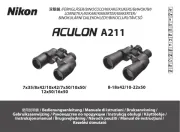
20 Mei 2025
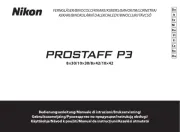
8 April 2025
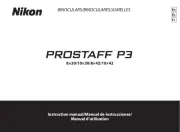
8 April 2025
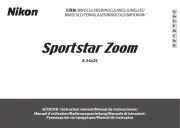
4 April 2025
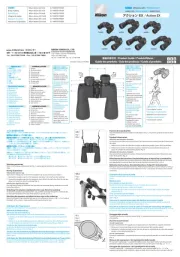
3 April 2025
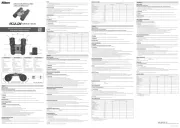
26 Maart 2025

20 Februari 2025

15 November 2024

3 Juni 2023

1 Juni 2023
Handleiding Verrekijker
- Leica
- Hama
- National Geographic
- Olympus
- Pulsar
- Eagle Optics
- Snypex
- Yukon
- Braun
- Trust
- Maginon
- Flir
- Umarex
- PARD
- Praktica
Nieuwste handleidingen voor Verrekijker

5 Augustus 2025

22 Juli 2025

22 Juli 2025
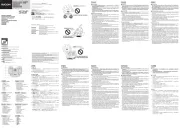
21 Juli 2025

21 Juli 2025
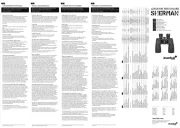
21 Juli 2025
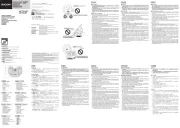
21 Juli 2025
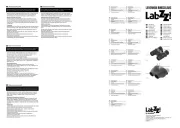
15 Juli 2025
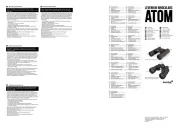
15 Juli 2025
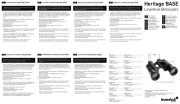
15 Juli 2025